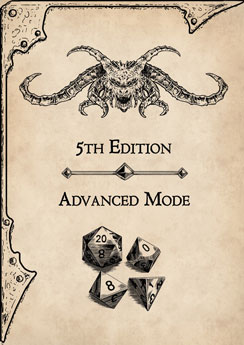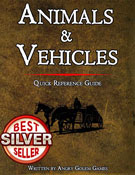Huge beast (animal), unaligned
Armor Class 13 (Natural Armor)
Armor Class (suggested) 16 (Natural Armor)
Hit Points 126 (11d12+55)
Hit Points (suggested)139 (13d12+55)
Speed 40 ft.
Proficiency Bonus +3
Proficiency Bonus +6 (5th Edition Advanced Mode)
| STR | DEX | CON | INT | WIS | CHA |
|---|---|---|---|---|---|
| 24 (+7) | 9 (-1) | 21 (+5) | 3 (-4) | 11 (+0) | 6 (-2) |
Skills (suggested) Perception +5
Senses passive Perception 10
Challenge 6 (2,300 XP)
Trampling Charge. If the mammoth moves at least 20 ft. straight toward a creature and then hits it with a gore attack on the same turn, that target must succeed on a DC 18 Strength saving throw or be knocked prone. If the target is prone, the mammoth can make one stomp attack against it as a bonus action.
ACTIONS
- Multiattack (suggested). The mammoth can make five attacks, two with its tusks, two with its feet and one with its trunk.
- Tusk (suggested). Melee Weapon Attack: +10 to hit, reach 10 ft., one target. Hit: 20 (3d6 + 7) piercing damage.
- Feet (suggested). Melee Weapon Attack: +10 to hit, reach 5 ft., one target. Hit: 16 (2d8 + 7) piercing damage.
- Trunk (suggested). Melee Weapon Attack: +10 to hit, reach 15 ft., one target. Hit: 14 (2d6 + 7) piercing damage. The target is grappled (escape DC 18) Until this grapple ends, the creature is restrained, and the elephant can’t constrict another target. Only large or smaller creatures can be grappled.
- Gore. Melee Weapon Attack: +10 to hit, reach 10 ft., one target. Hit: 25 (4d8 + 7) piercing damage.
- Stomp. Melee Weapon Attack: +10 to hit, reach 5 ft., one prone creature. Hit: 29 (4d10 + 7) bludgeoning damage.
5th Edition Advanced Mode
Limiting the power of a character and making the overall difficulty of the game harder, does not reduce the creativity, indeed it does quite the opposite.
The Game Master has the option to use any and all of the instances proposed in this guide, or just some of them according to their preference.
It is the lack of something that move and motivate characters, not the abundance of it
DESCRIPTION
A mammoth is a huge beast that resembles an elephant, but with thicker fur and longer tusks. Its fur can range from brown to black, and its tusks can measure up to 15 feet long. A mammoth can weigh up to 10 tons and stand up to 15 feet tall at the shoulder. A mammoth has a trunk that it uses to grab food, water, and objects, as well as to communicate with other mammoths. A mammoth also has large ears that help it regulate its body temperature and sense its surroundings.
COMBAT
A mammoth is a formidable opponent in combat, using its massive size and strength to crush and gore its enemies. A mammoth can charge at a great speed, knocking down and impaling its target with its tusks. A mammoth can also stomp on a prone creature, causing severe damage. A mammoth is not very agile, however, and can be outmaneuvered by smaller and faster foes. A mammoth is also vulnerable to fire and cold attacks, which can harm its fur and skin.
HABITAT / SOCIETY
A mammoth lives in a wide range of climates, from subarctic to subtropical regions. A mammoth prefers open grasslands and tundras, where it can find plenty of food and water. A mammoth can also adapt to forests and wetlands, but avoids deserts and mountains. A mammoth is a social animal, living in herds of up to 20 individuals. A herd is led by a dominant female, called a matriarch, who decides where to go and what to do. A herd also includes males, called bulls, who compete for the right to mate with the females. A herd protects its members from predators and other threats, using its collective strength and intelligence.
ECOLOGY
A mammoth is an herbivore, feeding on grasses, shrubs, fruits, nuts, and roots. A mammoth can consume up to 300 pounds of food per day, using its trunk to pluck and strip the vegetation. A mammoth also needs a lot of water, drinking up to 50 gallons per day. A mammoth can store water in its stomach for later use, as well as spray it from its trunk to cool itself or clean itself. A mammoth has few natural predators, but may be hunted by dragons, giants, or other powerful creatures. A mammoth may also be tamed or trained by humans or other intelligent races, who use it as a mount, a beast of burden, or a war machine.
Mammoths can be used as mounts or pulling animals for vehicles.
The statistics are detailed in the D&D 5e Animals & Vehicles reference guide.
Just have a look at the preview on DrivethruRpg.

